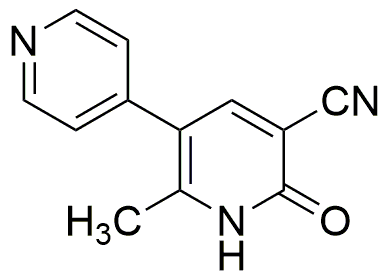Milrinone is widely utilized in research focused on:
- Cardiology: Milrinone is primarily used as a heart failure treatment. It helps improve heart contractility and reduce pulmonary vascular resistance, making it beneficial for patients with severe heart conditions.
- Anesthesia: In surgical settings, milrinone is often administered to manage hemodynamics during procedures, particularly in patients with compromised cardiac function, ensuring stable blood flow and oxygen delivery.
- Clinical Research: Researchers study milrinone's effects on various cardiovascular diseases, exploring its potential in combination therapies to enhance outcomes for heart failure patients.
- Pharmaceutical Development: The compound serves as a model for developing new inotropic agents, allowing scientists to innovate and improve medications that support heart function.
- Veterinary Medicine: Milrinone is also explored in veterinary applications, particularly for treating heart conditions in animals, showcasing its versatility beyond human medicine.
General Information
Properties
Safety and Regulations
Applications
Milrinone is widely utilized in research focused on:
- Cardiology: Milrinone is primarily used as a heart failure treatment. It helps improve heart contractility and reduce pulmonary vascular resistance, making it beneficial for patients with severe heart conditions.
- Anesthesia: In surgical settings, milrinone is often administered to manage hemodynamics during procedures, particularly in patients with compromised cardiac function, ensuring stable blood flow and oxygen delivery.
- Clinical Research: Researchers study milrinone's effects on various cardiovascular diseases, exploring its potential in combination therapies to enhance outcomes for heart failure patients.
- Pharmaceutical Development: The compound serves as a model for developing new inotropic agents, allowing scientists to innovate and improve medications that support heart function.
- Veterinary Medicine: Milrinone is also explored in veterinary applications, particularly for treating heart conditions in animals, showcasing its versatility beyond human medicine.
Documents
Safety Data Sheets (SDS)
The SDS provides comprehensive safety information on handling, storage, and disposal of the product.
Product Specification (PS)
The PS provides a comprehensive breakdown of the product’s properties, including chemical composition, physical state, purity, and storage requirements. It also details acceptable quality ranges and the product's intended applications.
Certificates of Analysis (COA)
Search for Certificates of Analysis (COA) by entering the products Lot Number. Lot and Batch Numbers can be found on a product’s label following the words ‘Lot’ or ‘Batch’.
*Catalog Number
*Lot Number
Certificates Of Origin (COO)
This COO confirms the country where the product was manufactured, and also details the materials and components used in it and whether it is derived from natural, synthetic, or other specific sources. This certificate may be required for customs, trade, and regulatory compliance.
*Catalog Number
*Lot Number
Safety Data Sheets (SDS)
The SDS provides comprehensive safety information on handling, storage, and disposal of the product.
DownloadProduct Specification (PS)
The PS provides a comprehensive breakdown of the product’s properties, including chemical composition, physical state, purity, and storage requirements. It also details acceptable quality ranges and the product's intended applications.
DownloadCertificates of Analysis (COA)
Search for Certificates of Analysis (COA) by entering the products Lot Number. Lot and Batch Numbers can be found on a product’s label following the words ‘Lot’ or ‘Batch’.
*Catalog Number
*Lot Number
Certificates Of Origin (COO)
This COO confirms the country where the product was manufactured, and also details the materials and components used in it and whether it is derived from natural, synthetic, or other specific sources. This certificate may be required for customs, trade, and regulatory compliance.


